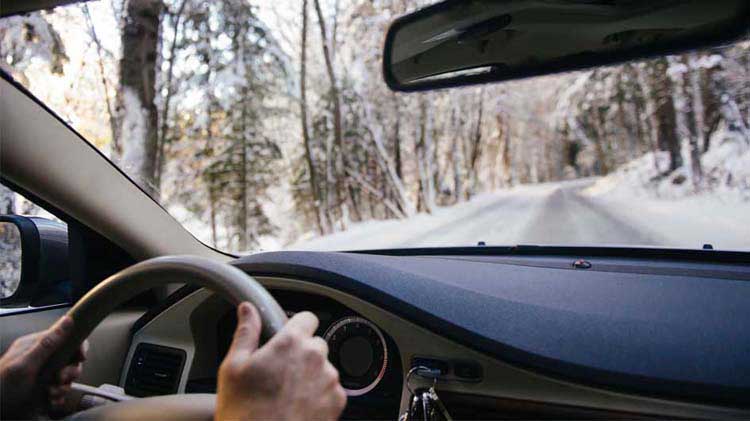
Ice and snow present serious risks to vehicle traction. It is imperative to maintain a safe distance between yourself and the car in front of you, and always brake gradually when stopping. Be cautious when approaching intersections, bridges, and shady areas as these can become dangerous due to black ice formation. If road conditions become unsafe, pull over immediately and wait until conditions improve before proceeding further.
1. Don’t Drive Too Fast
One of the leading causes of accidents is driving too fast for road and weather conditions; this is especially prevalent during the winter months when roads may be covered in ice or snow, increasing your risk of an accident. Staying within two seconds of other vehicles on icy roads makes stopping time much longer, so give them enough distance from you to allow for safe stopping times. Aim to leave at least two seconds between your car and those ahead. Do not apply sudden pressure to the brake pedal; doing so could cause your vehicle to skid and lose control. Instead, gradually reduce speed while using the brake pedal sparingly until regaining control.
2. Drive Slowly
Too fast for conditions is one of the primary causes of winter accidents. A vehicle traveling too fast cannot stop quickly enough or respond appropriately to changing road conditions, leading to collisions that result from an unsafe driving speed. Acceleration, turning, and braking all take longer on snow-covered roads, so drivers should adjust their driving accordingly – keeping within or under the posted speed limit and leaving extra distance between their car and those ahead of them. Also be extra wary when traveling over bridges, off-ramps, shady areas, or bridges that may become icy quickly – be particularly wary when crossing over bridges; be particularly wary around snowplows as these pose additional threats; always stay far enough behind them!
3. Keep Your Distance
Winter driving requires you to maintain a safe distance from vehicles in front of you, as too close proximity could result in rear-end collisions. As it takes longer to come to a stop on slippery surfaces, it is wise to increase the distance you typically keep behind when driving in snow, rain, or ice conditions. For optimal driving in these conditions, double or even triple your normal following distance. Be especially wary around snowplows, as their wake can lead to vehicles losing control. Additionally, be wary when crossing bridges since these typically freeze over before other areas and remain slippery for an extended period.
4. Don’t Pass Large Trucks
Large trucks have large blind spots that could obscure smaller vehicles from view, so avoid passing them if they are turning or switching lanes. As with passenger vehicles, trucks have longer stopping distances – and if their driver suddenly brakes your car could slide under them. If it becomes necessary to pass a truck, always do so quickly and carefully. Keep left of center and ensure you can see their driver in their side mirror before beginning to pass them.
5. Stay in Your Lane
Winter driving can be treacherous for even experienced drivers, making the following advice essential: follow weather and traffic advisories; only drive when necessary. Whenever driving alone, inform someone of your destination and expected arrival time. Be sure to clear all snow and ice from your vehicle prior to starting or during travel – especially mirrors and lights. Consider that acceleration, stopping, and turning take more time on snow and ice than on dry roads, so allow extra distance between vehicles in front of you. Black ice can be particularly hazardous to drive on, with bridges and shaded spots typically freezing first.
6. Don’t Activate Cruise Control
As soon as cruise control is engaged, your car begins braking more gradually in slippery conditions and may fail to stop on time if black ice or unplowed snow becomes present. This can be very hazardous. Always ensure you keep an eye out for potential ice and bridges or exit ramps that might freeze first – this way you won’t be caught unaware! Keep your foot on the brake pedal at all times to be prepared for sudden stops when necessary. Maintain clear windows so you have a full view in all directions, which will aid with visibility when driving in snowy conditions.
7. Keep Your Windows Clear
As visibility is essential when driving in winter weather, make sure your windshield, windows, mirrors, and lights are free from ice and snow before setting out on your journey. Carry an ice scraper just in case! Be extra wary when traversing bridges and overpasses as these tend to freeze first. Watch out for any slippery spots near shaded areas where pedestrians may slip. If your vehicle becomes stuck in the snow, be sure to remain inside, turn your hazard lights flashing, and hang a brightly-colored cloth from its antenna to help rescuers find you more quickly.
8. Don’t Forget About Your Pets
Winter brings beautiful landscapes, sparkling lights, and the joy of spending time with loved ones – but winter also presents many specific hazards that are unique to it. Cold temperatures and travel hazards pose serious threats that pose dangers to both you and your pets alike. Be wary of leaving your pet in a parked car as this could quickly chill them and lead to illness, particularly among young, old, or sick animals. Booties should be used to protect paws from road salt, antifreeze, and other chemicals as well as ensure collar and microchip information remain up-to-date.
9. Be Prepared
Winter weather requires preparation. Always consult the latest weather report before planning a trip and consider delaying non-essential travel until road crews have had time to treat roads. Also, keep your gas tank full and antifreeze regularly checked, while making sure mirrors, windows, and lights are free of snow or ice before driving as often as necessary. Practice your braking, steering, and acceleration skills in an empty parking lot before heading out in winter weather. By understanding how your car reacts in snow conditions you may be able to avoid becoming stuck or becoming involved in an accident.
